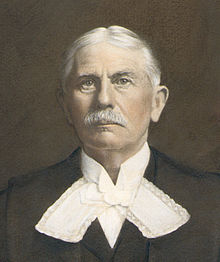|
Charles Johnston (New Zealand politician)
Sir Charles John Johnston (11 October 1845 – 13 June 1918) was a New Zealand politician. He was Mayor of Wellington in the Jubilee year and Speaker of the Legislative Council for the last three years of his life. BiographyHe was born on 11 October 1845 in Wellington, the son of merchant John Johnston, a scion of the Johnstons of Annandale.[1] He was educated at Wellington Commercial and Grammar School, and was later educated in England. He returned to New Zealand in 1864 and entered Johnston & Co who were ship owners and merchants. A brother Walter Woods Johnston was also an MP.[2] In 1869, Johnston was a lieutenant in the New Zealand militia. He subsequently joined the volunteers and when the Wellington Brigade formed was appointed to the rank of captain. When he moved to the active-reserve he was appointed Captain-Commandant.[3]
He represented the Te Aro electorate from 1881 to 1887, when he resigned.[4] He was a member of the Legislative Council from 1891 until his death in 1918,[5] and the Speaker from 1915 to 1918.[6] He was appointed from 22 January 1891 as one of seven new members (including Harry Atkinson himself) appointed to the council by the outgoing fourth Atkinson Ministry; a move regarded by Liberals as a stacking of the upper house against the new government.  Johnston was married to Alice Margaret Featherston (1850–1931), daughter of Isaac Earl Featherston. Two of his eight sons were killed in action in World War I, Brigadier-General Francis Earl Johnston and Captain Octavius Featherston Johnston. Another four of his sons also served in the war - Guy, Charles, Harold, and Ian Johnston. He also had three daughters – Zoë, Alice, and Doris. Zoë was widowed on the death of her husband William Fitzgerald Levin from injuries suffered at Gallipoli, while Doris married Hon. Nigel Gathorne-Hardy, who was aide-de-camp to the Governor-General of New Zealand from 1907 to 1910.[7] He died in Wellington on 13 June 1918 after a prolonged illness. He was to be knighted in 1918, but he died before the patent could be completed.[8] Notes
References |
||||||||||||||||||||||||||||||||||||||||||||||||||||||||||||
